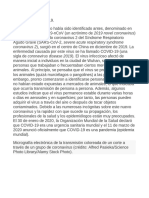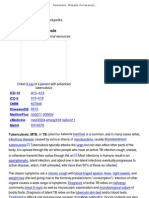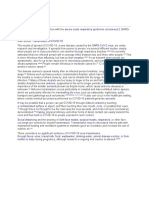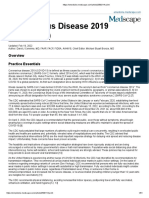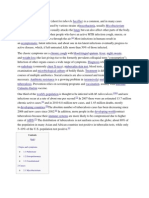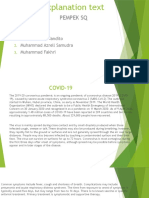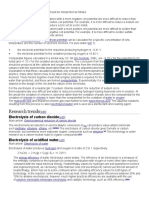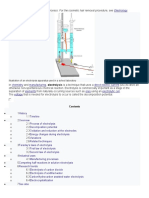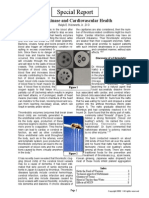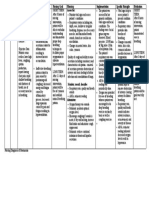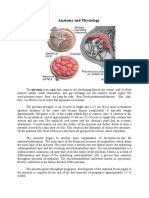Signs and Symptoms: Coronavirus Disease 2019
Signs and Symptoms: Coronavirus Disease 2019
Uploaded by
waseem555Copyright:
Available Formats
Signs and Symptoms: Coronavirus Disease 2019
Signs and Symptoms: Coronavirus Disease 2019
Uploaded by
waseem555Original Title
Copyright
Available Formats
Share this document
Did you find this document useful?
Is this content inappropriate?
Copyright:
Available Formats
Signs and Symptoms: Coronavirus Disease 2019
Signs and Symptoms: Coronavirus Disease 2019
Uploaded by
waseem555Copyright:
Available Formats
Signs and symptoms
Main article: Coronavirus disease 2019
Symptoms of COVID-19[388]
Symptoms of COVID-19 can be relatively non-specific and infected people may be asymptomatic. The two
most common symptoms are fever (88 per cent) and dry cough (68 per cent). Less common symptoms include
fatigue, respiratory sputum production (phlegm), loss of the sense of smell, loss of taste, shortness of breath,
muscle and joint pain, sore throat, headache, chills, vomiting, hemoptysis, and diarrhea.[389][390][391]
The WHO says approximately one person in five becomes seriously ill and has difficulty breathing.[8] The U.S.
Centers for Disease Control and Prevention (CDC) lists emergency symptoms as difficulty breathing, persistent
chest pain or pressure, sudden confusion, difficulty waking, and bluish face or lips; immediate medical attention
is advised if these symptoms are present.[15]
Further development of the disease can lead to potentially fatal complications including pneumonia, acute
respiratory distress syndrome, sepsis, septic shock, and kidney failure.[390]
Some of those infected may be asymptomatic, with no clinical symptoms but test results that confirm infection,
so researchers have issued advice that those with close contact to confirmed infected people should be closely
monitored and examined to rule out infection.[392] Chinese estimates of the asymptomatic ratio range from few
to 44 per cent.[393] The usual incubation period (the time between infection and symptom onset) ranges from
one to 14 days; it is most commonly five days.[394][8]
Cause
Transmission
Respiratory droplets produced when a man sneezes, visualised using Tyndall scattering
A video discussing the basic reproduction number and case fatality rate in the context of the pandemic
COVID-19 is a new disease, and the ways it spreads between people are under investigation, including: the
predominant role of small droplets, the extent to when and how it may be transmitted through air, and how long
expelled droplets remain infectious on surfaces.[8][9][11] The disease is spread during close contact, often by
small droplets produced during coughing, sneezing, or talking.[8][11] During close contact, (1 to 2 metres, 3 to 6
feet), people catch the disease after breathing in contaminated droplets that were exhaled by infected people.
However, the droplets are relatively heavy and usually fall to the ground or surfaces, as opposed to being
infectious over large distances.[8][11]
After the droplets fall to floors or surfaces, they still can infect other people, if they touch contaminated surfaces
and then their eyes, nose or mouth with unwashed hands.[8] On surfaces the amount of active virus decreases
over time until it can no longer cause infection.[11] However, experimentally, the virus can survive on various
surfaces for some time, (for example copper or cardboard for a few hours, and plastic or steel for a few days).
[11][395]
Surfaces are easily decontaminated with household disinfectants which kill the virus outside the human
body or on the hands.[8] Disinfectants or bleach are not a treatment for COVID-19, and cause health problems
when not used properly, such as inside the human body.[396]
Sputum and saliva carry large amounts of virus.[397][8][9][11] Some medical procedures may result in the virus
being transmitted easier than normal for such small droplets, known as airborne transmission.[8][11]
The virus is most contagious during the first three days after onset of symptoms, although spread is known to
occur up to two days before symptoms appear (presymptomatic transmission) and in later stages of the
disease.[9][11][398][399] Some people have been infected and recovered without showing symptoms, but
uncertainties remain in terms of asymptomatic transmission.[11]
Although COVID-19 is not a sexually transmitted infection, kissing, intimate contact, and faecal oral routes are
suspected to transmit the virus.[400][401]
Virology
Main article: Severe acute respiratory syndrome coronavirus 2
Illustration of SARSr-CoV virion
Severe acute respiratory syndrome coronavirus 2 (SARS-CoV-2) is a novel virus, first isolated from three
people with pneumonia connected to the cluster of acute respiratory illness cases in Wuhan.[334] All features of
the novel SARS-CoV-2 virus occur in related coronaviruses in nature.[402]
SARS-CoV-2 is closely related to SARS-CoV, and is thought to have a zoonotic origin.[331] SARS-CoV-2
genetically clusters with the genus Betacoronavirus, and is 96 per cent identical at the whole genome level to
other bat coronavirus samples[403] and 92 per cent identical to pangolin coronavirus.[404]
You might also like
- Food Allergies: A Complete Guide For Eating When Your Life Depends On It (A Johns Hopkins Press Health Book) - ISBN 9781421423388, 978-1421423388Document23 pagesFood Allergies: A Complete Guide For Eating When Your Life Depends On It (A Johns Hopkins Press Health Book) - ISBN 9781421423388, 978-1421423388adelindshawnu100% (17)
- The Ultimate Revision Basic Science: BY DR - Sherif Badrawy Critical CareDocument685 pagesThe Ultimate Revision Basic Science: BY DR - Sherif Badrawy Critical CareSherif Elbadrawy100% (1)
- SpedDocument5 pagesSpedJessica BrownNo ratings yet
- Coronavirus Disease 2019Document46 pagesCoronavirus Disease 2019Benjamin KonjicijaNo ratings yet
- Coronavirus Disease 2019Document30 pagesCoronavirus Disease 2019meNo ratings yet
- COVID Details Part 1Document8 pagesCOVID Details Part 1sirreNo ratings yet
- Coronavirus Disease 2019 (COVID-19) : This Article Is About The Disease. For The Virus, See - For The Pandemic, SeeDocument2 pagesCoronavirus Disease 2019 (COVID-19) : This Article Is About The Disease. For The Virus, See - For The Pandemic, Seearif iffatNo ratings yet
- Coronavirus Disease 2019 - WikipediaDocument349 pagesCoronavirus Disease 2019 - WikipediaWrohit XetriNo ratings yet
- Covid 19Document89 pagesCovid 19Bhavish UbNo ratings yet
- Coronavirus Disease 2019: Jump To Navigation Jump To SearchDocument49 pagesCoronavirus Disease 2019: Jump To Navigation Jump To SearchRaquel Paleyan CalawenNo ratings yet
- Ringkasan COVID Kesan Dan Kebaikkan Serta KemungkinanDocument2 pagesRingkasan COVID Kesan Dan Kebaikkan Serta KemungkinanzwiezackNo ratings yet
- Coronavirus Disease 2019 1Document10 pagesCoronavirus Disease 2019 1princeb4meNo ratings yet
- Signs and SymptomsDocument7 pagesSigns and SymptomsJV DeeNo ratings yet
- Common Cold: From Wikipedia, The Free EncyclopediaDocument9 pagesCommon Cold: From Wikipedia, The Free EncyclopediaazetteaNo ratings yet
- Signs and symptomsDocument7 pagesSigns and symptomsnurulfadilah34No ratings yet
- Science Projek Power Point AJJ 0608Document7 pagesScience Projek Power Point AJJ 0608qyin2579No ratings yet
- Coronavirus Disease 2019Document1 pageCoronavirus Disease 2019Albean DelojeroNo ratings yet
- Coronavirus Disease 2019 (COVID-19) Is AnDocument2 pagesCoronavirus Disease 2019 (COVID-19) Is AnSadhak AarushNo ratings yet
- COVID-19 PresentationDocument25 pagesCOVID-19 PresentationGiorgi KenkebashviliNo ratings yet
- CORONAVIRUS TEAM 4Document10 pagesCORONAVIRUS TEAM 4Wendy PerezNo ratings yet
- The Coronavirus DiseaseDocument1 pageThe Coronavirus DiseaseMark BryanNo ratings yet
- Introduction To COVIDDocument7 pagesIntroduction To COVIDqaseem2109No ratings yet
- Omar Taha - Nishteman Farzad - Ahmed Gaeib - Aven Majeed - Abdulwahab Ahmed - Lavan Majeed - Tabark KhawlanDocument45 pagesOmar Taha - Nishteman Farzad - Ahmed Gaeib - Aven Majeed - Abdulwahab Ahmed - Lavan Majeed - Tabark KhawlanAhmed HusseinNo ratings yet
- Influenza, Commonly Known As "The Flu", Is AnDocument18 pagesInfluenza, Commonly Known As "The Flu", Is Anvibs1994No ratings yet
- Social Internship ProjectDocument42 pagesSocial Internship ProjectAbul FazalNo ratings yet
- Coronavirus Disease 2019Document4 pagesCoronavirus Disease 2019Rodmar EscolanoNo ratings yet
- Colona Vilus Part 2Document5 pagesColona Vilus Part 2Mynutsa SmellyNo ratings yet
- COVID-19 - WikipediaDocument46 pagesCOVID-19 - WikipediaAlexa AlexaNo ratings yet
- Boletin CovidDocument4 pagesBoletin Covidmonica.parra.ojedaNo ratings yet
- Common ColdDocument24 pagesCommon Coldxiang_xiang56No ratings yet
- Covid 19Document8 pagesCovid 19AZLINA AZRAAINo ratings yet
- Tuberculosis - Wikipedia, The Free EncyclopediaDocument15 pagesTuberculosis - Wikipedia, The Free EncyclopediaitsmepranielNo ratings yet
- Cause: TransmissionDocument6 pagesCause: Transmissionmarcos callaNo ratings yet
- COVID1Document3 pagesCOVID1Dez TabiosNo ratings yet
- CauseDocument1 pageCauseSadhak AarushNo ratings yet
- Medscape All Covid 19Document81 pagesMedscape All Covid 19david dompeipenNo ratings yet
- Coronavirus OutbreakDocument4 pagesCoronavirus OutbreakXyster AmarNo ratings yet
- Coronavirus DiseaseDocument5 pagesCoronavirus DiseaseShanice BedecirNo ratings yet
- Posistion Paper Eap PTDocument5 pagesPosistion Paper Eap PTeddie semblanteNo ratings yet
- Assignment On Airborne DiseasesDocument3 pagesAssignment On Airborne DiseasesJishnu K PrasadNo ratings yet
- Tuberculosis, MTB, or TB (Short For TubercleDocument14 pagesTuberculosis, MTB, or TB (Short For TubercleRakhi RameshNo ratings yet
- Types of Influenza VirusesDocument105 pagesTypes of Influenza Virusesjohn dadisNo ratings yet
- Cause of Covid-19: TransmissionDocument2 pagesCause of Covid-19: TransmissionRodmar EscolanoNo ratings yet
- Coronavirus (Covid 19)Document6 pagesCoronavirus (Covid 19)Tour De BandarbanNo ratings yet
- Improving Safety in Dental Practices During The COVID 19 PandemicDocument10 pagesImproving Safety in Dental Practices During The COVID 19 PandemicAmina KEDDARNo ratings yet
- Corona Aka Covid 19Document6 pagesCorona Aka Covid 19Anmesh keruNo ratings yet
- CoronavirusDocument1 pageCoronavirusKavya TummepalliNo ratings yet
- PandemiaDocument2 pagesPandemiaorianamichelle10No ratings yet
- Covid 19 - WikipediaDocument38 pagesCovid 19 - Wikipediazona amrullohNo ratings yet
- COVID-19: Paper Assignment Submitted To Fulfill One of The English AssignmentsDocument7 pagesCOVID-19: Paper Assignment Submitted To Fulfill One of The English AssignmentsHasna Rizqi fadilahNo ratings yet
- COVID-19 Pandemic - WikipediaDocument89 pagesCOVID-19 Pandemic - WikipediasallyNo ratings yet
- Coronavirus Assignment Info (To Summarize)Document12 pagesCoronavirus Assignment Info (To Summarize)iammateoguzman100% (1)
- Diphtheria Is An: Corynebacterium DiphtheriaeDocument4 pagesDiphtheria Is An: Corynebacterium DiphtheriaeAlie LegaspiNo ratings yet
- Covid Implication - S GowrishankarDocument16 pagesCovid Implication - S Gowrishankardr.sgowrishankarNo ratings yet
- Covid 19 by Maryem HazemDocument56 pagesCovid 19 by Maryem HazemAhmed HusseinNo ratings yet
- Project On Covid-19Document22 pagesProject On Covid-19Yashasvi SharmaNo ratings yet
- Dengue FeverDocument15 pagesDengue Feverankeritenursing 647No ratings yet
- Communicable Disease Prevention - 10232020Document21 pagesCommunicable Disease Prevention - 10232020barlyalrajeevkumar268No ratings yet
- New Microsoft Word DocumentDocument14 pagesNew Microsoft Word DocumentShravan ZoneNo ratings yet
- He COVID-19 Pandemic, Also Known As The Coronavirus Pandemic, Is An OngoingDocument1 pageHe COVID-19 Pandemic, Also Known As The Coronavirus Pandemic, Is An Ongoingoppo f1No ratings yet
- Explanation Text CoronaDocument9 pagesExplanation Text CoronaAqila Bilbina0% (1)
- Report On The Global Statistical Data of COVIDDocument3 pagesReport On The Global Statistical Data of COVIDChristian Angelo G. MontigoNo ratings yet
- Ramadan Ks3 III Y91Document26 pagesRamadan Ks3 III Y91waseem555No ratings yet
- Civ 2Document5 pagesCiv 2waseem555No ratings yet
- Form 4 Home Work and ExamplesDocument13 pagesForm 4 Home Work and Exampleswaseem555No ratings yet
- Vectors Part 4 Collinear VectorsDocument8 pagesVectors Part 4 Collinear Vectorswaseem555No ratings yet
- Case Fatality Rate: Total Confirmed Deaths Due To COVID-19 Per Million PeopleDocument3 pagesCase Fatality Rate: Total Confirmed Deaths Due To COVID-19 Per Million Peoplewaseem555No ratings yet
- Civ 1Document5 pagesCiv 1waseem555No ratings yet
- Civ 5Document3 pagesCiv 5waseem555No ratings yet
- Apprenticeship Systems Worldwide: AustraliaDocument3 pagesApprenticeship Systems Worldwide: Australiawaseem555No ratings yet
- Canada: Province Compulsory TradesDocument2 pagesCanada: Province Compulsory Tradeswaseem555No ratings yet
- Apprenticeship After General EducationDocument4 pagesApprenticeship After General Educationwaseem555No ratings yet
- Apprenticeship: "Apprentice" Redirects Here. For Other Uses, SeeDocument4 pagesApprenticeship: "Apprentice" Redirects Here. For Other Uses, Seewaseem555No ratings yet
- Fire Extinguisher: "Extinguisher" Redirects Here. Extinguisher May Also Refer To ADocument4 pagesFire Extinguisher: "Extinguisher" Redirects Here. Extinguisher May Also Refer To Awaseem555No ratings yet
- Early Life: Mechanical Engineer Inventor Hydraulics Fire HydrantDocument3 pagesEarly Life: Mechanical Engineer Inventor Hydraulics Fire Hydrantwaseem555No ratings yet
- Fire Hydrant: Jump To Navigation Jump To SearchDocument7 pagesFire Hydrant: Jump To Navigation Jump To Searchwaseem555No ratings yet
- 2 FireDocument3 pages2 Firewaseem555No ratings yet
- United Kingdom: Bsen3 RAL 3000 Color Coded Fire ClassesDocument5 pagesUnited Kingdom: Bsen3 RAL 3000 Color Coded Fire Classeswaseem555No ratings yet
- Fire Sprinkler: HistoryDocument5 pagesFire Sprinkler: Historywaseem555No ratings yet
- Stuntmen: Fire Extinguishers in A Museum Storeroom, Cut To Display Their Inner WorkingsDocument4 pagesStuntmen: Fire Extinguishers in A Museum Storeroom, Cut To Display Their Inner Workingswaseem555No ratings yet
- Fire Protection: Classifying FiresDocument3 pagesFire Protection: Classifying Fireswaseem555No ratings yet
- Electrolysis 5Document4 pagesElectrolysis 5waseem555No ratings yet
- Fire 5Document6 pagesFire 5waseem555No ratings yet
- Manual Fire Suppression: Edit EditDocument3 pagesManual Fire Suppression: Edit Editwaseem555No ratings yet
- Fire Dampers For DuctsDocument3 pagesFire Dampers For Ductswaseem555No ratings yet
- See Also: Carbon/hydrocarbon Assisted Water ElectrolysisDocument3 pagesSee Also: Carbon/hydrocarbon Assisted Water Electrolysiswaseem555No ratings yet
- Alchemy 6Document6 pagesAlchemy 6waseem555No ratings yet
- Research Trends: Electrolysis of Carbon DioxideDocument5 pagesResearch Trends: Electrolysis of Carbon Dioxidewaseem555No ratings yet
- This Article Is About The Chemical Process. For The Cosmetic Hair Removal Procedure, SeeDocument4 pagesThis Article Is About The Chemical Process. For The Cosmetic Hair Removal Procedure, Seewaseem555No ratings yet
- Core Concepts: HermeticismDocument4 pagesCore Concepts: Hermeticismwaseem555No ratings yet
- This Article Is About The Chemical Process. For The Cosmetic Hair Removal Procedure, SeeDocument5 pagesThis Article Is About The Chemical Process. For The Cosmetic Hair Removal Procedure, Seewaseem555No ratings yet
- Alchemy 4Document3 pagesAlchemy 4waseem555No ratings yet
- Disability AnimalPolicyDocument10 pagesDisability AnimalPolicycommanderkeenNo ratings yet
- JR Type of FolliculitisDocument8 pagesJR Type of FolliculitisridhaNo ratings yet
- How-to IMT application + interview guideDocument23 pagesHow-to IMT application + interview guideRissaNo ratings yet
- Palatal Fistula: Dr. Amru Sungkar, SPB-SPBPDocument48 pagesPalatal Fistula: Dr. Amru Sungkar, SPB-SPBPlukhoriNo ratings yet
- Case Presntation NURSING CARE PLANDocument6 pagesCase Presntation NURSING CARE PLANmadhurima kunduNo ratings yet
- Title: A Case Report On Left-Sided AppendicitisDocument10 pagesTitle: A Case Report On Left-Sided AppendicitispigzeniNo ratings yet
- Nattokinase and Cardiovascular HealthDocument8 pagesNattokinase and Cardiovascular HealthIhorNo ratings yet
- Assignment 3 - Asthma and Bronchiolitis - Case StudyDocument4 pagesAssignment 3 - Asthma and Bronchiolitis - Case StudyChaerin LeeNo ratings yet
- Fundamentals of NursingDocument77 pagesFundamentals of NursingXena IngalNo ratings yet
- Esic Joka (Anaethesia) Esanjeevaniopd: General Examination & Chief ComplaintsDocument1 pageEsic Joka (Anaethesia) Esanjeevaniopd: General Examination & Chief ComplaintsSourav BiswasNo ratings yet
- Expanding Mental Health Care in The Kingdom of Eswatini: Successes, Challenges and Recommendations From Initial Experiences in Lubombo RegionDocument8 pagesExpanding Mental Health Care in The Kingdom of Eswatini: Successes, Challenges and Recommendations From Initial Experiences in Lubombo RegionCOMDIS-HSDNo ratings yet
- Package PAU (Veg)Document73 pagesPackage PAU (Veg)Gary Bhullar100% (10)
- PEH12 Q3 Mod1 MovingOnAdaptingTheNewNormal v4Document21 pagesPEH12 Q3 Mod1 MovingOnAdaptingTheNewNormal v4Stephen Gimotea100% (3)
- Barret's Syndrome Case ReportDocument3 pagesBarret's Syndrome Case ReportResearch ParkNo ratings yet
- IV FluidsDocument6 pagesIV FluidsAr-jay PorrasNo ratings yet
- Nursing Diagnosis PneumoniaDocument1 pageNursing Diagnosis PneumoniaPasa ShresthaNo ratings yet
- Pathophysiology of Pott'S DiseaseDocument4 pagesPathophysiology of Pott'S Diseasee3runeNo ratings yet
- Anatomy and Physiology of PlacentaDocument5 pagesAnatomy and Physiology of PlacentaAmuNo ratings yet
- 834 Food Nutrition Dietetics MsDocument8 pages834 Food Nutrition Dietetics MsHarshitaNo ratings yet
- Bio Immune Gas Exchange MarkschemeDocument4 pagesBio Immune Gas Exchange Markschemeyt kNo ratings yet
- A Presentation On Hot Fomentation and Hot SpoonDocument21 pagesA Presentation On Hot Fomentation and Hot Spoongideon A. owusuNo ratings yet
- Instant download Oxford textbook of violence prevention epidemiology evidence and policy First Edition Donnelly pdf all chapterDocument81 pagesInstant download Oxford textbook of violence prevention epidemiology evidence and policy First Edition Donnelly pdf all chaptersidonafendy100% (2)
- Effect of Root Canal Procedures On Endotoxins and Endodontic PathogensDocument8 pagesEffect of Root Canal Procedures On Endotoxins and Endodontic PathogensSaadAzizNo ratings yet
- Heart Attack EssayDocument2 pagesHeart Attack EssayRatih ParamitaNo ratings yet
- SATO Dental Asymmetry - TMDDocument5 pagesSATO Dental Asymmetry - TMDJorge Mori VelásquezNo ratings yet
- MOTIV ManagingShrimpHealth DR - HoaDocument35 pagesMOTIV ManagingShrimpHealth DR - HoakhanhsunjinNo ratings yet




























